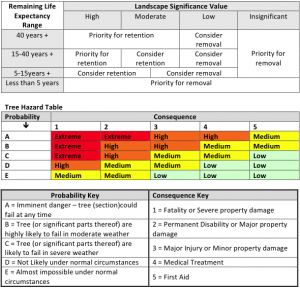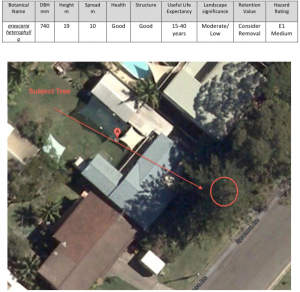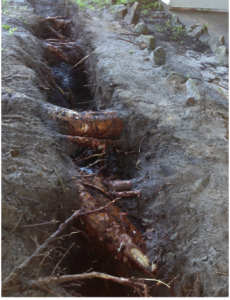Below is a sample of an Arborist report done on a Norfolk Island Pine in Bateau Bay that was doing damage to the owners house. The outcome of the report was that the tree should be removed. Wyong Council approved the application for the tree removal.
1. Introduction
This report was commissioned by Mr Jones, owner of 208 Sycamore Avenue, Bateau Bay to assess the health, condition and hazard of an araucaria heterophylla (Norfolk Island Pine) located on in the front yard of the property. Concern has been raised due to the structural damage the tree is causing to the driveway and the house.
2. Methodology
The subject tree was assessed by visual means only, no destructive samples were taken as part of this assessment. No excavation or exploration of the root system was undertaken as part of this assessment.
Tree Height was estimated.
Trunk diameter at breast height (dbh) was measured at 1.4 metres above ground level.
Canopy diameter was measured and rounded to the nearest metre.
Tree health was determined by assessing:
- Foliage size and colour.
- Pest and disease infestation.
- Extension growth.
- Canopy density.
- Percentage of deadwood.
- Presence of epicormic growth.
Tree structure was assessed by:
- Visible evidence of structural defects or instability.
- Evidence of previous pruning or physical damage.
Tree hazard was assessed with regards to three main components (Harris, Clark & Matheny 2004)
- The severity of the defect.
- The size of the defective part.
- The person(s) or object(s)that would be injured or damaged if failure occurred (the target).
- The prevailing site conditions that may contribute to failure.
The Remaining Life Expectancy Range is an estimate of the longevity of the subject tree in its current growing conditions. This was calculated by estimating the expected lifespan of the species; less the subject trees’ estimated current age and growing conditions
Landscape Significance was determined by assessing the combination of the cultural, environmental and aesthetic value of the subject tree. Whilst this value is subjective, it provides a relative value of the trees landscape significance, which may aid in determining a Retention Value.
The following criteria have been used to determine the Landscape Significance of the subject tree.
High
- The subject tree is listed as a Heritage item under the Local Environment Plan with a local or state level of significance.
- The subject tree forms part of the curtilage of a heritage item.
- The subject tree creates a ‘sense of place’ or is considered a ‘landmark’ tree.
- The subject tree is of local, cultural or historical importance or is widely known.
- The subject tree is listed on the Wyong or Gosford Councils’ Significant Tree Register.
- The subject tree is scheduled as a Threatened Species or Threatened Plant Community under the Threatened Species Conservation Act (1995).
- The subject tree is a remnant tree.
- The subject tree provides habitat to a threatened species.
- The subject tree is an excellent representative of the species in terms of aesthetic value.
Moderate
- The subject tree makes a positive contribution to the visual character or amenity of the area.
- The subject tree provides a specific function such as screening or minimising the scale of a building.
- The subject tree has a known habitat value.
- The subject tree is a good representative of the species in terms of aesthetic value.
Low
- The subject tree is an environmental pest species or is exempt under the local Councils’ Tree Preservation Order.
- The subject tree makes little or no contribution to the amenity of the locality.
- The subject tree is a poor representative of the species in terms of aesthetic value.
- The subject tree is causing damage to a significant structure.
Insignificant
- The subject tree is declared a Noxious Weed under the Noxious Weeds Act (1993).
Retention Value was based on the subject trees’ Remaining life Expectancy Range, Landscape Significance and Hazard Rating. The Retention Value was modified to take into consideration the subject trees’ health, structure and site suitability.
3. Subject Tree
The subject tree was identified as an araucaria heterophylla (Norfolk Island Pine). The tree is a semi-mature specimen with a single trunk up to 18m.The tree in fair health and condition displaying average foliage size, density and colour. No apparent structural tree defects were present at the time of inspection.
4.The Site
The tree is located in the residential allotment in Bateau Bay. The tree is growing in perfect conditions for its species in an open full-sun position in well-drained sandy soil. The subject tree is growing within 1.5 metres of the driveway and 4m from the house. The tree roots are starting to affect the driveway. A trench has been excavated 1.2 m from the house using hand tools to assess the root system impacting the house (see image A. below). These are significant structural roots approx 250mm in diameter. The owner is concerned of the impact the tree roots may have on the house foundations.
5. Discussion
Norfolk Island Pines have gained an iconic status among coastal towns of NSW and have been widely planted along the Wyong Regions coastal areas. In good conditions Norfolk Island pines will live for 100+ years and attain heights of over 40 metres with canopy spread over 15 metres.
This subject tree is a vigorous growing semi-mature specimen, which would be expected to grow at least another 30% in height, diameter and canopy spread in its life-time.
The root system of the tree has substantial structural roots radiating out from the trunk under the house and driveway. These roots will continue to grow and may cause structural damage to the house foundations. For this reason the tree has been given a Low to Moderate ULE (Useful Life Expectancy) as it may be retained for more than 15 years with an acceptable level of risk, however, it would be removed during the course of normal management for safety or nuisance reasons as it is “causing damage to a significant structure”.
Pruning of the roots that impact structures is an alternative to removal in many cases. The pruning of roots in this case would remove substantial structural roots that may lead to decline in tree health and stability.
6. Conclusion
- Retention of the tree will likely to cause structural damage to the driveway and house foundations.
- Pruning of the tree roots will be detrimental to tree health and stability and is not recommended.
7. Recommendations
- Remove the tree and replace with a suitable native species as recommended by Wyong Shire Council. Tree planting should be carried out by an Arborist or Horticulturalist with minimum AQF 3. The replacement tree should be planted away from buildings and driveways to avoid future problems.
- Tree removal should be carried out by a suitably qualified and insured Arborist with minimum AQF3.
- All work should be carried out in accordance with the Work Cover Code of Practice for the Amenity Tree Industry 1998 and WH&S regulations.



